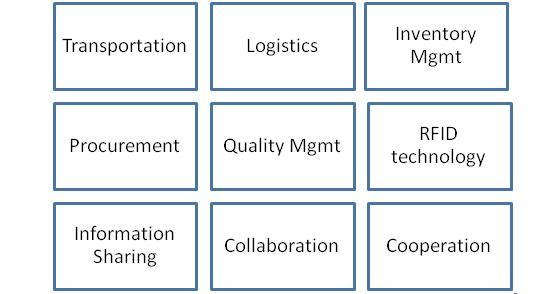- Articles ›
- Operations and IT ›
- Emergence of Supply Chain Management in Healthcare Industry Articles
Emergence of Supply Chain Management in Healthcare Industry
With the onset of 1990s, there has been an increasing focus on supply chain management and their role within the strategy of the firm. Effective supply chain management is defined the management of supply chain assets, products, data and money flow to maximize the overall profitability and improve consumer responsiveness. A successful supply chain is one that shares data between various stakeholders- suppliers, manufacturers, custom departments, LSP (Logistics Service Provider) and retailers. Improving efficiency of logistics and the operations of supply chains and the production network has the potential to stimulate economic growth. If all countries were to improve their logistics performance and supply chain barriers to just half the level observed in the best-performing country in their respective regions, global GDP could increase by 2.6%. (Bank, January, 2014). Such increase in GDP could have positive impact on unemployment. (Bank, January, 2014).

Image Courtesy: freedigitalphotos.net, renjithkrishnan
Inefficient logistics and supply chain can create uncertainty and variability. A recent study related to the adoption of advanced supply chain solutions in Latin America showcased that retailers in this region are holding inventories twice as compared to U.S. counterparts. (Bank, January, 2014). It was also found that post-harvest losses (PHL) of fruits and vegetables in India was about Rs 2 lakh crore in 2011-2012 (ASSOCHAM, 2013). Some of the causes for such huge loss were lack of appropriate storage leading of bio-deterioration or pest attack, inefficient transportation etc. The World Bank estimates that transport costs per ton Km from farm to primary markets are 3-5 times higher than those from secondary to wholesale markets in capital cities
To avoid this situations, countries have pursued the development of logistics to address their challenges e.g. in Central American countries like Honduras, the focus is on improving road network. Guatemala is working on “Technological Corridor”.
Other future trends that will shape the logistics and supply chain network are the Asset Flexibility, Internet of things, Big Data, RFID supply chain solutions and e-commerce.
Supply Chain Management in Healthcare:
The Healthcare Industry is one of the biggest and fastest growing industries. Supply chain management is more complex in healthcare as compared to other industries as it has direct impact on the health of the people who require adequate medical supplies in accordance with the patient’s needs.
In healthcare, supply chain management is a new and improved way of managing the medical supplies. It is a set of methods to integrate suppliers and hospital services efficiently by optimising the utilization of resources and achieve total quality management.
The general structure of Supply Chain in Healthcare looks like this:

Fig 1: Healthcare Supply Chain Structure
In a nutshell, we can define Healthcare supply chain management as the management of materials like medical equipments, medical supplies like medicines, bandages, p.o.p, syringes, etc. manpower like physicians, specialists, nurses, etc. to treat the sick patient efficiently at a reasonable and affordable cost, in the shortest time, with the maximum patient’s satisfaction.
The best practices of healthcare supply chain are:

The common issues in the healthcare supply chain are:
1. Distribution of Network Configuration: It deals with the warehouse’s location, production level of goods, etc. It also deals with to finalize the distribution network between the suppliers and hospitals to minimise transportation and inventory costs.
2. Supply Contracts: This deal with maintaining cordial relationships between the suppliers and hospitals by signing Supply Contracts. These contracts specify price, discounts, lead time, quality, etc.
3. Distribution of supplies: A hospital will have to make decisions regarding the storage of supplies or direct delivery at the point of use.
4. Integration and Partnering: It deals with the implementation of CPFR- Collaborative Planning, Forecasting and Replenishment, among hospitals and suppliers and manufacturers of medical supplies.
5. Customer Value: It can be measured by the ability to deliver utmost quality service to the patients. It can be measured in terms of services offered, price charged and perceived value.
Benefits of Supply chain management in healthcare are:
1. Streamlined workflow
2. Control over inventory
3. Improved synergy between finance and material department
4. Improvement in vendor management
5. Empowered procurement staff
6. Improvement in sourcing, pricing, contract management, inventory management, etc.
With the suitable supply chain management system in place, one can eliminate administrative duties and paper work. By incorporating this, the hospital’s staff can focus more on valuable and strategic tasks – hence overall improve quality of care.
This article has been authored by Nitin Sehgal from IMT Ghaziabad
References
Charu, S., n.d. Trends, Issues and Solutions from a Logistics Perspective, Michigan: s.n.
Everard, L. J., 2001. Blueprint for an efficient Health Care Supply Chain. s.l.:s.n.
Infor Lawson Supply chain Management for Healthcare (2013) Infor.
Reza, M. F., 2012. Design and Analysis of a Health Care Supply Chain Management. Volume 433-440, pp. 2128-2134.
Supply Chain Management in Hospital (2008) Samuel, Mary , Y. Helio, San Diego State University, San Diego, CA.
Views expressed in the article are personal. The articles are for educational & academic purpose only, and have been uploaded by the MBA Skool Team.
If you are interested in writing articles for us, Submit Here
Share this Page on:
What is MBA Skool?About Us
MBA Skool is a Knowledge Resource for Management Students, Aspirants & Professionals.
Business Courses
Quizzes & Skills
Quizzes test your expertise in business and Skill tests evaluate your management traits
All Business Sections
Write for Us